Chapter 8: Preset Menu 109
• Solo Mode
Solo mode provides the playing action of a monophonic instrument. It
can make wind and string instruments sound more realistic by prevent-
ing more than one note from sounding at once. Two types of solo mode
are provided: Wind Controller mode and Synth mode. In either solo
mode, if a new note is played while another is being held, the envelope
generators do not retrigger and the sample remains in the loop. This
allows a legato playing technique to be used.
Wind Mode
The envelope generator attack always begins at the start of the
attack phase when playing staccato. When playing legato, the
envelope generator stays in the sustain phase.
Synth Mode
The envelope generator attack begins at whatever point in the
release phase is in when a new key is pressed. When playing legato,
the envelope generator stays in the sustain phase.
SOLO MODE
p:Off s:Wind
Changing the Loop Offset Start point moves the loop forward or backward (+ or-)
through the sample memory, keeping the loops size constant. Large changes will
move the loop completely out of the original sample.
Changing the Loop Offset Size alters the size of the loop, leaving the loop start point
stationary. Large positive offsets will enlarge the loop to encompass multiple samples.
Piano Choir Strings Brass Synth
Loop Loop+ Start Point
Loop
Sample Memory
- Start Point
Strings Brass Synth
Loop
Loop Size
Sample Memory
PRESET MENU
••• Sounds are looped so
that they will continue to
sound as long as the key is
held.
••• When using a negative
loop start point, the sound
may jump back to a point
before the start of the
sample during the loop cycle.
••• Solo Mode allows you to
simulate certain playing
techniques such as
“Tongueing” on a saxo-
phone, where the attack is
only heard on certain notes.

